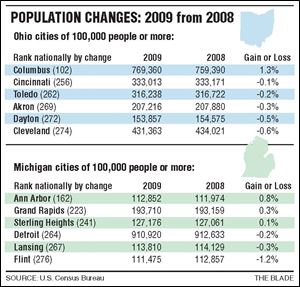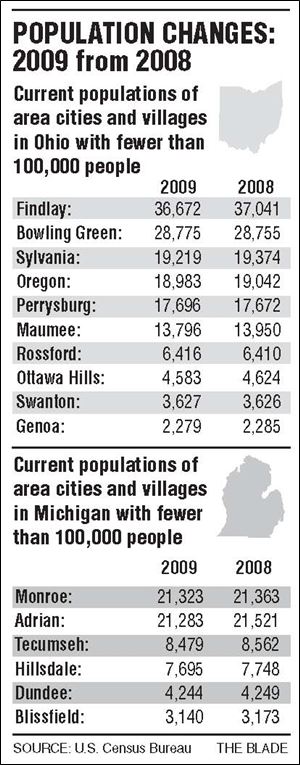
Census estimate shows a decline in Toledo population
6/23/2010
If you live in Toledo, you're part of a city in decline.
Bummer. We've heard it before. Over and over and over. Toledo is hurting.
The latest set of U.S. Census Bureau estimates - not to be confused with the official 2010 Census count, which is still being tabulated - shows Toledo's population probably eroded 0.2 percent between July 1, 2008, and July 1, 2009.
But there's good news. The estimated change from April 1, 2000, through July 1, 2009, shows that Toledo's population probably grew 0.8 percent, from 313,784 to 316,238. That's because Toledo grew slightly until 2005, then went on the decline.

CLICK TO ENLARGE
So things aren't quite so bad, eh? It's all a matter of perspective, according to Dean Monske, Toledo's deputy mayor for external affairs and chief handler of economic development issues for Mayor Mike Bell.
What do the differences in changes mean in the big picture?
Probably not too much, according to Mr. Monske, who said what is most important is the city has remained comfortably above the 300,000 mark, a cutoff point for certain types of federal funding.
Robert Groves, Census Bureau director, said, "Census numbers govern the distribution of more than $400 billion in federal funds each year and serve as the baseline for future post-Census population estimates. Local governments use census data to plan new roads, schools, and emergency services. Businesses use the data to develop new economic opportunities."

CLICK TO ENLARGE
The latest Census Bureau estimate shows Toledo with 316,238 people as of last July 1, making it the nation's 60th-largest city.
A fraction of a percentage here and a fraction of a percentage there - it's really not a deal-maker or deal-breaker for wooing companies, Mr. Monske said.
If anything, it's just another talking point for a politician if his city happens to be ranked near the top, another feather in a recruiter's cap.
"As someone who's lived here my whole life, it's not even a discussion to have," Mr. Monske said, explaining that assets such as a skilled work force and the region's low cost of living, its transportation network, and other amenities are what get emphasized.
"At the end of the day, it's not rocket science. You either have [what a business needs] or you don't."
Still, Toledo is probably lower in the population rankings than it would like. Its slight decline put it in 262nd place for population growth among the nation's 276 cities with populations of 100,000 or more. For the decade, it was 212th.
Mr. Bell could not be reached for comment. But his predecessor, former Mayor Carty Finkbeiner, said last year he didn't "put a whole heck of a lot of stock" into the estimates that were released in 2009. Some might argue he understated his position then, though, because he had led a successful drive to get the 2007 estimate readjusted upward by 21,822, enough to keep the city over the 300,000 mark.
The estimates show Toledo probably has plenty of company in a downward spiral, with most area communities in Michigan and Ohio losing population last year compared with 2008. It's a trend that has been in place for years as more Americans move to the South and the West.
"Many baby boomers and young adults are still in a holding pattern," said Mark Mather, associate vice president at the nonprofit Population Reference Bureau. "They are staying close to big cities where most jobs are located, waiting for the economy and housing market to bounce back before they make their next move."
Some area communities, such as Monroe County's Bedford Township, posted small gains. Bedford probably gained 16 people, to 31,126 on July 1, 2009, according to the estimates.
Columbus was the only major Ohio city that appeared to gain people. Declines were believed to have occurred in others, with Cleveland and Flint, Mich., faring among the worst nationally.
The statistics can reflect the aftereffects of a natural disaster as much as prolonged economic decay.
New Orleans is an example. No other city came close to losing a greater percentage of population between 2000 and 2009 than did the Big Easy, which experienced a 26.8 percent drop over that period - largely a result of the numbers forced to relocate because of Hurricane Katrina in 2005.
Yet New Orleans was ranked as the nation's fourth-fastest growing city from July 1, 2008, to July 1, 2009, an indication that it is rebounding from one of the worst hurricanes in decades.
The Census Bureau said its official 2010 count - which Congress uses to determine how many seats each state gets in the U.S. House of Representatives - is to be completed by December.
Contact Tom Henry at:
thenry@theblade.com
or 419-724-6079.